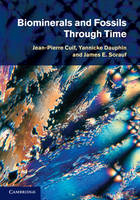
Biominerals and Fossils Through Time
Cambridge University Press (Verlag)
978-0-521-87473-1 (ISBN)
Fossils are essential to the reconstruction of the evolution of life and episodes in Earth history. Knowledge of biomineralization - the processes associated with the formation of mineralized biological structures - is essential to properly evaluate data derived from fossils. This book emphasizes skeletal formation and fossilization in a geologic framework in order to understand evolution, relationships between fossil groups, and the use of biomineral materials as geochemical proxies for understanding ancient oceans and climates. The focus is on shells and skeletons of calcareous organisms, and the book explores the fine structures and mode of growth of the characteristic crystalline units, taking advantage of most recent physical methodological advances. The book is richly illustrated and will be of great interest to advanced students and researchers in paleontology, Earth history, evolution, sedimentology, geochemistry, and materials science.
Jean-Pierre Cuif is a Professor in the Department of Geology at the Université de Paris-Sud II, Orsay, France. Since 1980 his research team has developed a specialized approach to the mineralized units that built the calcareous skeletons of invertebrates through Earth history. In addition to basic research on distribution and composition of the organic compounds associated with the mineral phase, this approach has led to the participation of the team in multiple programs dealing with biomineralization in economically important molluscs. Yannicke Dauphin is an Assistant Professor at Université de Paris VI (Pierre et Marie Curie), Paris, France. She worked in Jean-Pierre Cuif's biomineralization research team at the Université de Paris-Sud II. After focussing on cephalopod shells, she has extended her research on the structure and composition of modern and fossil molluscs, corals and vertebrate skeletons. James E. Sorauf taught sedimentology and paleontology at the State University of New York at Binghamton from 1962 until becoming emeritus in 2001. He has published approximately seventy papers in peer-reviewed journals on skeletal structures of modern corals and on systematics and paleobiology of fossil corals ranging in age from Cambrian to Pleistocene. He is a former co-editor of Fossil Cnidaria and Porifera. He was a Trustee of the Paleontological Research Institution in Ithaca, New York for many years, serving as President of their Board of Trustees from 1988 to 1990.
Preface; 1. The concept of microstructural sequence, as exemplified by mollusc shells and coral skeletons; 2. Compositional data on mollusc shells and coral skeletons; 3. Origin of microstructural diversity; 4. Diversity of structural and growth-mode patterns in skeletal Ca-carbonate of some plants and animals; 5. Connecting the layered growth and crystallization model to the chemical and physiological approaches; 6. Micro-crystallized and amorphous biominerals in bones, teeth and siliceous structures; 7. More information from the fossil records through a better understanding of their diagenetic behavior and fossilization status of biominerals; References; Index.
| Erscheint lt. Verlag | 23.12.2010 |
|---|---|
| Zusatzinfo | 5 Tables, black and white; 225 Halftones, black and white; 48 Line drawings, black and white |
| Verlagsort | Cambridge |
| Sprache | englisch |
| Maße | 178 x 253 mm |
| Gewicht | 1130 g |
| Themenwelt | Sachbuch/Ratgeber ► Natur / Technik ► Natur / Ökologie |
| Naturwissenschaften ► Geowissenschaften ► Mineralogie / Paläontologie | |
| ISBN-10 | 0-521-87473-4 / 0521874734 |
| ISBN-13 | 978-0-521-87473-1 / 9780521874731 |
| Zustand | Neuware |
| Informationen gemäß Produktsicherheitsverordnung (GPSR) | |
| Haben Sie eine Frage zum Produkt? |
aus dem Bereich


